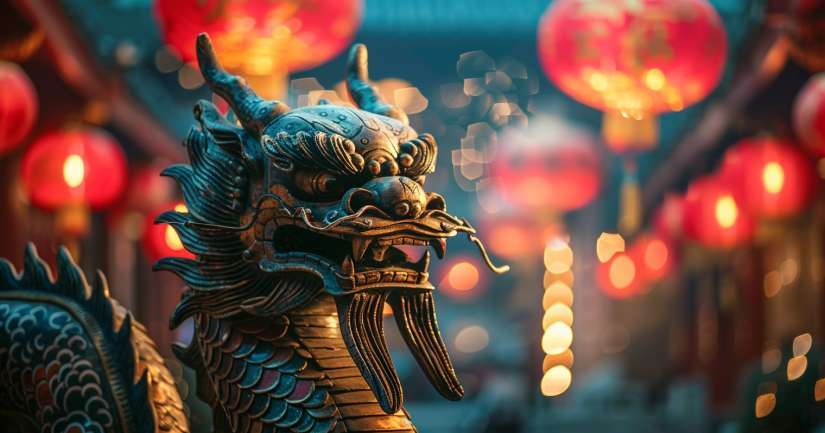
Get ready to dive into the vibrant world of Chinese New Year Trivia Quiz, Test Your Knowledge of Traditions, Symbols, and Festivities. The Chinese New Year Trivia Quiz challenges your understanding of one of the world’s most vibrant celebrations. Also known as the Spring Festival (春节, Chūn Jié), Chinese New Year marks the start of the lunar calendar and represents renewal, family, and prosperity. People celebrate with firecrackers, red decorations, and festive feasts, following customs that date back thousands of years. This quiz will test your knowledge of Chinese New Year’s history, traditions, and cultural significance.
For over 4,000 years, people in China have celebrated the lunar new year through rituals and festivities. According to legend, the mythical beast Nian (年兽) terrorized villages every New Year’s Eve. To drive it away, villagers used loud noises, bright lights, and the color red. These traditions evolved into the modern-day fireworks, red lanterns, and lucky decorations that define the festival.
Celebrate the season by learning which zodiac represents you with the Which Chinese Zodiac Am I Quiz. Or, for a personal twist, uncover What Is My Chinese Name. When you’ve learned all you can here consider diving into What Toy Are You Quiz for a surprising twist. You’ll pondering as you compare your results and maybe see how surprising life can be. Then saunter over to What Are My Interests Quiz and keep the humor rolling.
Step Into the Chinese New Year Trivia Quiz
The Origins and History of Chinese New Year
How the Lunar Calendar Determines the Date
Unlike the Gregorian calendar, which follows a fixed 365-day cycle, the Chinese calendar follows moon phases. As a result, the New Year falls between January 21 and February 20, depending on the lunar cycle. Each year corresponds to one of 12 zodiac animals, creating a repeating 12-year cycle. Every zodiac sign also links to one of the Five Elements (Wood, Fire, Earth, Metal, and Water), forming a 60-year cycle that influences personality traits and fortune predictions.
Traditional Chinese New Year Customs and Superstitions
During the Spring Festival, families follow customs meant to bring luck and prosperity:
- Cleaning the house before New Year’s Eve: People sweep away bad luck to welcome positive energy.
- Reunion dinner (年夜饭, Niányèfàn): Families gather for a feast featuring dishes that symbolize wealth and happiness.
- Firecrackers and fireworks: These loud explosions scare away evil spirits and mark a fresh start.
- Wearing red clothing: Red represents good fortune and offers protection from misfortune.
- Avoiding negative words: Saying words related to death, misfortune, or failure is considered unlucky.
The Meaning Behind Chinese New Year Foods
Many traditional dishes carry symbolic meanings:
- Dumplings (饺子, Jiǎozi): Their shape resembles ancient gold ingots, symbolizing wealth.
- Fish (鱼, Yú): A sign of abundance, often served whole to represent unity and completeness.
- Longevity noodles (长寿面, Chángshòu Miàn): Their long strands symbolize a long and healthy life.
- Sticky rice cake (年糕, Niángāo): The name sounds like “higher year,” symbolizing growth and progress.
The Lantern Festival: Closing the New Year Celebrations
The Lantern Festival (元宵节, Yuánxiāo Jié) marks the end of Chinese New Year celebrations on the 15th day of the lunar calendar. Families light colorful lanterns, solve riddles, and eat sweet rice dumplings (汤圆, Tāngyuán) to symbolize unity. Dragon and lion dances fill the streets, ensuring a joyful and prosperous year ahead.
How Well Do You Know Chinese New Year?
Chinese New Year blends ancient traditions, lucky customs, and cultural symbolism. Whether you celebrate it every year or are learning about it for the first time, this quiz will challenge your knowledge of one of the world’s most joyful and meaningful festivals. Take the Chinese New Year Trivia Quiz and see how much you know about this celebration!
China Quizzes – Explore the Wonders …
Chinese New Year – FAQ
Chinese New Year, also known as the Spring Festival, is the most important traditional holiday in China. It marks the beginning of the lunar new year, usually falling between January 21 and February 20. Celebrations last for about 15 days and include family reunions, feasts, and cultural activities.
Chinese New Year is celebrated to honor deities and ancestors. It is a time for families to gather, reflect, and look forward to a prosperous new year. The holiday is filled with rituals and traditions meant to bring good luck, health, and fortune.
Common traditions include cleaning the house to sweep away bad luck, decorating with red lanterns and banners, and giving red envelopes filled with money to children. Fireworks and lion dances are popular to ward off evil spirits and bring good fortune.
The Chinese New Year date is determined by the lunar calendar, which is based on the moon’s cycle. It typically falls on the second new moon after the winter solstice. This is why the date varies each year but always occurs between late January and mid-February.
During Chinese New Year, families enjoy a variety of symbolic foods. Dumplings represent wealth, fish symbolizes abundance, and rice cakes convey the hope for a higher income or position. Fruits like oranges and tangerines are also popular as they signify good luck and fortune.
